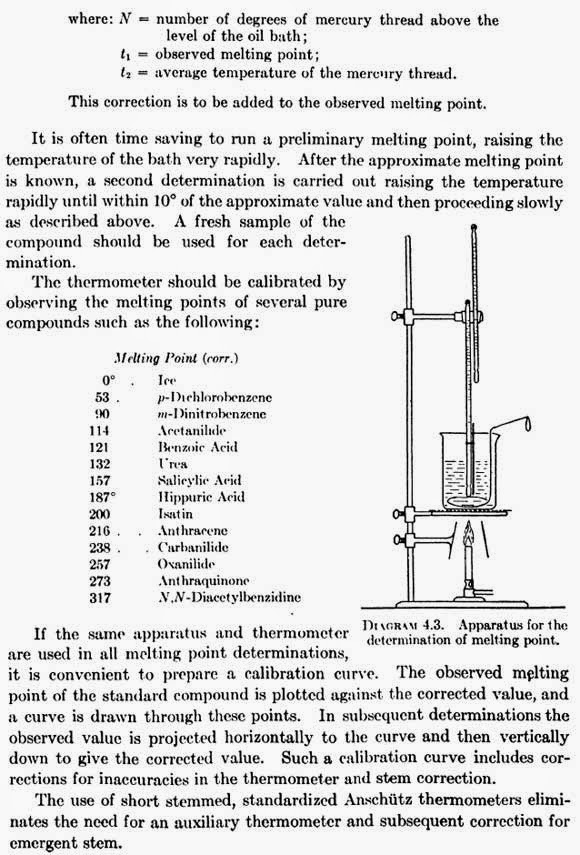7. MELTING POINT
The importance of the determination of the
melting point of a solid, crystalline material is obvious.
A brief but comprehensive discussion of the
determination of melting points has been given by Shriner and Fuson,42 from
which much of the following is taken.
Procedure: Heat a piece of 15
mm. glass tubing43 in a flame until the glass is soft; then draw out into a thin
walled capillary tube about 1 mm. in diameter. Cut into lengths of about 6 cm.,
and seal one end in a name. Powder a small amount of the compound in a polished
agate mortar and introduce some of the powder into the capillary tube. Hold the
capillary tube vertically and gently rub with a file, which causes the powder to
settle to the bottom ; pack the material by tapping the tube on the desk. Fasten
the tube to the thermometer by means of a rubber band (cut from a piece of rubber
tubing) so that the sample is close to the mercury bulb (see Diagram 4.3). Place
a heavy white mineral oil in the beaker and heat with a low flame. Clamp a cylindrical
metal shield, open at the top and bottom, in the position as shown in Diagram 4.3
in order to protect the flame from drafts. Heat at a rate to cause a rise in temperature
of about 1o or 2o per min. Stir the oil bath continuously.
Note the temperature at which the compound starts to melt44 and that
at which it is entirely liquid; record these values as the melting point range.
Note also the temperature recorded by the auxiliary thermometer (t2) ', the bulb of this thermometer
should be placed midway between the surface of the oil and the top of the mercury
thread in t1. Calculate the
stem correction by means of the following formula :
Correction = 0.0001 54N(t1 - t2)
---------------------
41 "The
Systematic Identification of Organic Compounds," John Wiley & Sons, Inc.,
New York (1940), 85.
49 Soft
glass test tubes are very satisfactory since the walls are relatively thin.
44 According
to "The United States Pharmacopoeia," Thirteenth Rev., 668, the temperature
at which the column of the sample is observed to collapse definitely against th
side of the tube at any point is defined as the beginning of the melting. The temperatur
at which the material becomes liquid throughout is defined as the end of the melting.
It is important to record the melting point range
of a compound since this is a valuable index of purity. A large majority of pure
organic compounds melt within a range of 0.5o or melt with
decomposition over a narrow range of temperature (about 1o).
When determining the melting point of a solid
that readily sublimes e.g., borneol certain precautions become necessary. The rate
of heating of the oil bath should be increased considerably. The capillary should
not be introduced into the hot oil until the temperature is within 10o
to 20o of the expected melting point. The use of a sealed capillary may
be necessary, i.e., a capillary that has both ends fused. The use of a Fisher-Johns
or similar type apparatus is not recommended for materials that sublime readily.
Other types of melting point apparatus have
proven satisfactory e.g., the Fisher-Johns, Thiele, and Thiele-Dennis.
If a compound has a high melting point a Maquenne
block may conveniently be used. It is claimed that the Dennis melting point apparatus
is very satisfactory for compounds melting up to 300o.
Special types have been developed for determination
of the melting point of waxes,45 and the softening point of amorphous
material.46
---------------------------
45
A.S.T.M. Melting
Point Apparatus, Designation D87.
46
A.S.T.M. Softening
Point Apparatus (Ring
and Ball
Method), Designation
D36.



0 Comment:
Post a Comment